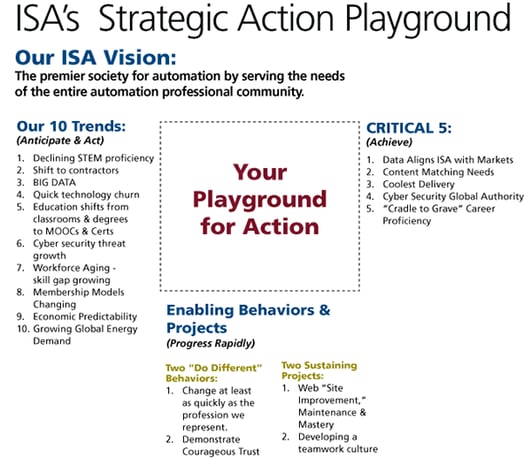This post is authored by Peggie Koon, president of ISA 2014.
For as long as I can remember, almost every time I have traveled by car to a place, even if I have been there in the past, I check to make sure I have directions. Today that typically means that I enter the destination in my car’s WAAS/GPS (wide area augmentation system/global positioning system). The system in my car looks at my starting point and my destination, calculates the miles, and asks me which route I’d like to take. I get to choose the fastest route, most scenic tour, etc.
destination, calculates the miles, and asks me which route I’d like to take. I get to choose the fastest route, most scenic tour, etc.
Once I select the route, my expected arrival time is calculated. And if I accept the proposed roadmap, I am given turn-by-turn directions to my destination. What I like most about this system is that when I get off course, e.g. if I get off the roadmap, it quickly alerts me and tells me how to get back on track – then recalculates the time it will take to reach my destination. And if there’s a barrier to entry—a wreck, back logged traffic, roadwork, or a roadblock—the system tells me how to maneuver so I stay on track to reach my goal.
These navigation systems use information about where I am and where I want to go in the future, plus all the data about every potential path available to provide the optimal set of step-by-step directions so I reach my destination. And they are fast and agile, so that as soon as they see a potential opportunity – something that can either expedite or inhibit my success – they quickly alert me, provide me with alternatives, and get me back on the road again. Using this automated system, I have a strategy and plan for getting from point A to point B. And I can envision getting there on time (or not). If you’re like me, even though you have the system, you start looking ahead at the road signs along the way…
Wouldn’t it be nice if ISA could just enter our 5 strategic goals into a strategic WAAS/GPS, touch a screen, and voilà - out comes the strategic road map with step-by-step directions to success? Maybe and maybe not. For us humans, developing a roadmap for success is not quite that automated or automatic. In fact, for organizations, it often turns out much better when strategic vision, direction, and related actions are determined via a deliberate collaborative process that includes very deep levels of engagement so all stakeholders in the organization are on board, in sync, and headed in the same direction.
During the last weekend in June, ISA Leaders did just that! The 2014 Summer Leaders Meeting (SLM) was all about developing a strategic plan to help ISA move forward successfully towards developing an action plan for achieving the 5 strategic goals that were established for our Society at the Executive Summit held in January of this year. As a reminder, the 5 goals are:
- Data -- ISA will be market driven, using data to help us focus our development of products and services so they meet the needs of the automation (and control) professional and the automation (and control) community.
- Content – ISA will use the latest technology to develop content that meets the needs of the automation professional, (not just for his/her current job but for career development), and the automation community (industries, organizations, academia, and government), they serve.
- Coolest Delivery – ISA will deliver content using the coolest technology available. This means using technology so that our content can be easily consumed by next-generation automation professionals.
- Global Authority on ICS Cybersecurity – Through the work of the Automation Federation (AF), the National Institute of Standards and Technology (NIST) and the Department of Homeland Security (DHS), ISA is already considered a global authority on industrial control systems cybersecurity with ISA99, an internationally recognized standard for cybersecurity. ISA will continue to work with governments, academia, and private industry to promote the use of the standard, enhance the standard, and to provide mission-critical operational IT training to protect and secure critical infrastructure from cyber threats.
- Advocacy of automation as a profession – ISA will continue to be an advocate of automation as a profession, working to “tell our story” in powerful ways to enhance and promote the importance of creating and evolving STEM (science, technology, engineering and mathematics) education and STEM careers, from cradle to grave.
Righting and Writing the Vision
There are two old sayings that I love related to visioning. The first says: “Where there is no vision, the people perish.” The second says once you have a vision you must: “Right the vision and make it plain.”
As a reminder, we stated ISA’s Vision for 2014 through 2019 as follows:
ISA will be the premier society for automation by serving the needs of the entire automation professional community.
Our success will be indicated by growth in membership and users and a lowering in the average age of our audience, reflecting a younger average age more representative of automation professionals today.
So how do we “right” the vision? One way to ensure that we’re on the right track is to make sure that ISA is market/data driven. We recognized this need and targeted being market driven as one of our 5 strategic goals. We also acknowledged the need to form powerful relationships with industry leaders so that they become advisors to ISA—not just about our future but about how we can better serve them both now and in the future. To that end, in January, we revitalized the old Industry Advisory Council and asked the Board to approve the formation of an ISA Automation Advisory Council (AAC). Just prior to the SLM, Society leaders began the process of “righting” the vision with our very first Automation Advisory Council meeting. ISA Automation Advisory Council members are:
- Billy Bennett, CEO, Pyramid ODI
- Paul Galeski, CEO, Maverick
- Nelson Norden, Director Global Business Development & Strategic Planning, Emerson Automation Solutions
- Peggie Koon, ISA President
- Rick Roop, ISA President-elect, Secretary
- Pat Gouhin, ISA Executive Director, CEO
During the meeting we asked industry advisors to share their perceptions about:
- ISA today - We wanted to hear what these industry leaders think about our Society, its value proposition for their industry, the automation professional, and the automation community.
- The current needs of the automation industry – We wanted to understand what they see as critical needs in the automation industry. Along with that we asked if ISA is capable of meeting any of those needs today.
- What ISA should change to meet industry needs – We wanted to know what we need to change or do differently to meet those needs?
- What ISA should continue doing to meet industry needs – We wanted to understand what we are doing now that we should continue to do or perhaps expand to meet industry needs now and in the future
We also shared ISA’s 5 game-changing goals and asked if they felt we are on target. The feedback we received from the AAC was both confirming and convicting. As I listened to these movers and shakers in the automation industry I was laser focused on envisioning a future through their eyes and understanding how to integrate their ideas and suggestions into our established goals.
For example, members of the AAC talked about how using words like automation and automation professional might leave a perception that the needs of the control industries and control systems professionals are no longer the focus of ISA. This perception is absolutely false! Those of us in ISA know that for us, the word automation encompasses the full scope of automation (delivery) and control (function). So how do we tell our story with messaging that reinforces this? We must be very cognizant and deliberate in our marketing and promotion efforts so we are explicitly inclusive of the full breadth and scope of products and services offered by ISA for both automation (delivery) and control (function).
Another point made was related to our proposed metrics, which at first glance appear to focus on growing the number of young/next-generation professionals and the exclusion of older and retiring members of the automation community. If you think about this perception, it’s easy to see the conundrum between measuring success via lowering age of membership and the goal of cradle-to-grave advocacy of automation as a profession. For example, workforce development has been identified as a critical need for the automation industry. A large part of this need comes from the hiring of young professionals who lack the necessary skill sets of the aging workforce. Might ISA fill this gap by being the conduit to bring aging and retired automation subject matter experts into agreements with the automation industry to provide the necessary training for this next generation of automation professional? Does this opportunity then change the metrics by which we measure success?
In his summary of the meeting, Pat Gouhin wrote: “We have a beautiful opportunity as a Society, with a distinguished, knowledgeable base, to do a knowledge transfer like no one else in the world. ISA should be the conduit to take the knowledge into the next generation. And because we have an older demographic they most likely want to fuel the transfer and would willingly help if given the right program/format.”
Paul Galeski asked the group this very powerful question: “Who is your customer?” This simple question led to a very lengthy discussion of ISA, membership, our value proposition, competing interests and the variety of customer bases we serve.
At one point Peter Martin said that our 5 game-changing goals were notionally correct but our scope was too narrow.
Finally, I asked each AAC member to tell us one thing ISA absolutely must do to be successful. Here’s the list of phrases we were given:
- Be Customer Focused – Know them and adapt to them
- Go Faster – Minimize distraction
- Take a Leadership Role in positioning the value of industrial automation to all constituencies
- Be Cradle-to-Grave advocates of automation as a profession
- Demonstrate Courageous Trust in an Innovative Pilot
This Automation Advisory Council meeting was the first of several we plan to hold this year. The feedback we received from these industry leaders was shared in our SLM sessions and will allow us to continually right our vision so that ISA’s goals remain aligned with the needs of automation professionals, the automation community, and the industries they serve.
2014 ISA Strategic Planning – A Plain Old Action Plan
It was not only exciting to be involved in this year’s SLM but it was equally stimulating to watch! Leaders from assemblies, divisions, and departments engaged in strategic planning sessions to develop specific actions their constituents would complete to help ISA accomplish our strategic goals.
After a brief kick-off meeting during which Society leaders (Peggie Koon, Jim Keaveney, and Jon DiPietro) set expectations for the meeting, Billy Bennett, CEO of Pyramid ODI, facilitated brainstorming and group-think exercises that reinforced the need for teamwork and for all of us to be laser focused on achieving the same set of goals. The levels of engagement during, between, and after the sessions were more than we experienced in a while! Leaders and staff were in collaborative, interactive sessions defining the specific tasks they planned to achieve for the remainder of 2014 and through 2015—all related to the goals that were established by the Society. And as a part of the effort, these same leaders identified several things they would stop doing, too!
After being on the “playground”, ISA leaders and staff all came together at the Strategic Planning Department (SPD) meeting to give a recap of meeting outcomes to SPD. It was incredible to sit back and listen to each group share their respective goals and related action items during the Wrap Up session. A highlight of this report out was the Content Roadmap developed by Shari Worthington and the Publications Department team. And all of the leaders (from each assembly, division, and department) gave well-planned presentations that articulated their commitment to do their part and to be evangelists—to spread the word to their constituents—to encourage folks to get involved.
Lest we forget…
If you recall in January we began two investigative initiatives to flesh out the potential opportunity for ISA in cybersecurity and shale gas. Eric Cosman and Dean Ford each gave report outs on the status of their initiatives to the Executive Board.
The Shale Gas initiative had great momentum then lost steam because of a lack of resources. After much discussion, the Executive Board acknowledged its support of completing the investigative effort by allocating seed money for business plan development related to the Shale Gas Initiative.
Eric Cosman reminded us that while ISA continues the work it began years ago with regard to cybersecurity, the effort has been and will for the foreseeable future be focused on completing the standards. ISA continues to need vetted resources who can serve as subject matter experts (SMEs) to help with the demands of the workforce development and training pieces of the cybersecurity opportunity.
Can you see the duck?
This year’s Summer (or Spring depending on who you ask) Leaders Meeting was phenomenal! Every session was interactive, engaging, collaborative, and fun! We even started the group event with a “Name that Nerd” game that ended in a fierce competition requiring group think, communication, and collaboration. The levels of synergy and energy were extremely high all weekend long. And at the end of the meeting, I felt like we accomplished all that I had envisioned and more! I could begin to see the duck!
Ok…all right…so, you’re wondering: What does the SLM have to do with seeing a duck? At the beginning of our Executive Board session, I asked Billy Bennett to share his thoughts about our progress, where we are, and how well we accomplished the meeting goals. He gave us a postmortem and ended his discussion with a story about a retiree who took up wood carving as a hobby. The man didn’t think he would be very good at it, but he trained and studied, and became an amazing carver of wood ducks. (Read the full story here: http://www.pyramidodi.com/blogs/my-dads-lesson-on-vision-see-the-duck)
Almost always people who saw one of his ducks would say to him: “That is so lifelike, how do you do that?” The man’s immediate reply was: “It’s easy, all you do is carve away anything that doesn’t look like a duck.”
He had a clear vision of what the duck should look like so that at every stage of the carving, he could see what he needed to carve away…He could “see” the duck!
As I listened to Billy (and later read the story), I thought what a wonderful mantra for ISA.
For me, the first lesson from the story is that getting there—achieving our goals—is a process. It will take time, effort, and commitment. And we need to have a clear vision of what we want to achieve—who we want to be—and a plan to get there.
Secondly, we can’t do everything. This means in order to achieve our goals, we too must be willing to carve away those things that don’t “fit” with the vision—that don’t look like a duck!
And finally, we don’t have a navigation system that can automatically look ahead and tell us how to maneuver through all the bumps and roadblocks along the way that we are likely to encounter as we pursue our goals. But if we can just stay focused on the vision—if we can keep chipping away until we see the duck —we, too, can successfully achieve our goals!
We had a great SLM! It was only the beginning of a journey towards a successful future for ISA!
Come join us! Get involved!
About the Author Peggie Koon, Ph.D., is vice president of audience at Chronicle Media and The Augusta Chronicle, which are part of Morris Publishing Group, LLC, a privately held media company based in Augusta, Ga. Prior to joining Morris, Peggie spent more than 25 years developing IT systems for process automation and process con–trol in a variety of industries, including automotive, nuclear defense, aerospace, nuclear reprocessing, thermal ceramics and textiles. Peggie assumed her first ISA leadership position in 1996 as membership chair of the Management Division and has held a variety of prominent leadership roles in the Society. She earned a bachelor's degree in mathematics from Smith College in Northampton, Mass. and completed graduate studies in industrial and systems engineering at the Georgia Institute of Technology. She received a doctorate in management information systems from Kennedy Western University in Cheyenne, Wyo.
Peggie Koon, Ph.D., is vice president of audience at Chronicle Media and The Augusta Chronicle, which are part of Morris Publishing Group, LLC, a privately held media company based in Augusta, Ga. Prior to joining Morris, Peggie spent more than 25 years developing IT systems for process automation and process con–trol in a variety of industries, including automotive, nuclear defense, aerospace, nuclear reprocessing, thermal ceramics and textiles. Peggie assumed her first ISA leadership position in 1996 as membership chair of the Management Division and has held a variety of prominent leadership roles in the Society. She earned a bachelor's degree in mathematics from Smith College in Northampton, Mass. and completed graduate studies in industrial and systems engineering at the Georgia Institute of Technology. She received a doctorate in management information systems from Kennedy Western University in Cheyenne, Wyo.
Connect with Peggie:![]()
![]()
![]()
A version of this article also has been published in ISA Insights.




